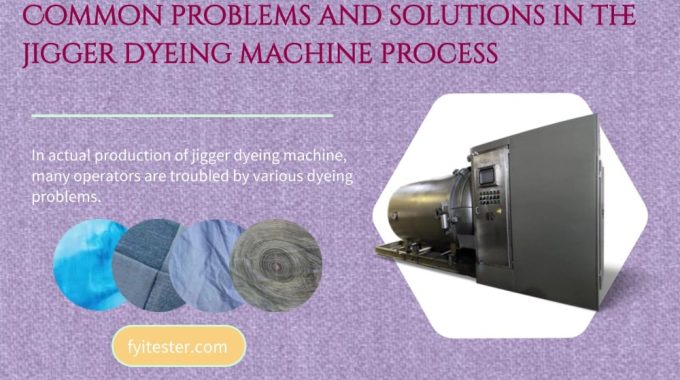
Problems and solutions in the jigger dyeing machine process
In the textile printing and dyeing industry, the jigger dyeing machine has become the preferred equipment for many companies due to its high efficiency and uniform dyeing effect. However, in actual production, many operators are troubled by various dyeing problems.
What are the common problems in the jigger dyeing machine process?
- Color shading, color stains, color difference, weft skew, warp skew, wrinkles, crease, loose – board mark, water marks, etc.
Contents
Color shading and stains
What are color shading and stains? Why do they appear on the fabric? How to solve the problem if they occur during the dyeing process of the jigger dyeing machine?
- Color shading: the color of the fabric is different, with patches or stripes;
- Color stain: irregular dark stains appear on the fabric.
- Causes: improper selection of dyes; incorrect use of auxiliaries; improper control of process parameters; incomplete cleaning of equipment.
- Solutions:
1) Optimize dye selection: Select appropriate dyes according to fiber types to ensure good dyeing results.
2) Correct use of auxiliaries: Add leveling agents and other auxiliaries in strict accordance with process requirements to ensure uniform dispersion of dyes.
3) Accurately control process parameters: Reasonably set the heating speed, insulation time and cooling process to ensure that the dyes are fully penetrated and fixed.
4) Clean equipment regularly: Thoroughly clean the dye tanks and pipes before each dyeing to avoid residues from contaminating new batches.
Color difference
What is color difference? Why does color difference occur during the dyeing process of the jigger dyeing machine? How to solve the color difference problem?
- Color difference: There are color differences between dyed products of the same batch or different batches, which affects the overall consistency and aesthetics.
- Causes of color difference: inconsistent dye ratio; changes in process parameters; differences in operator skills.
- Solution:
1) Strictly control the dye ratio: adopt a standardized dye ratio scheme to ensure that the dye ratio of each batch is consistent.
2) Keep the process parameters stable: reasonably set and keep the process parameters stable during the dyeing process to avoid color differences caused by parameter fluctuations.
3) Strengthen personnel training: improve the skill level and experience accumulation of operators to reduce color differences caused by human factors.
Weft and warp skew
Why does the weft and warp appear skew during the dyeing process of the jigger, and why does the dyed cloth have wrinkles and creases? How to solve these problems?
- Weft and warp skew: The weft or warp yarns of the fabric tilt during the dyeing process, causing the finished product to deform in size and affecting the use effect.
- Wrinkles and creases: The surface of the fabric becomes uneven after dyeing, affecting the appearance quality and feel.
- Causes: improper tension control; incorrect position of the guide wheel; problems with the fabric itself.
- Solution:
1) Adjust tension control: According to the fabric type and process requirements, reasonably adjust the tension of the jigger to ensure smooth operation of the fabric.
2) Correct the position of the guide wheel: Regularly check and adjust the position of the guide wheel to ensure that it is in the correct position.
3) Choose high-quality fabrics: Control the quality of the fabric from the source, and choose fabrics with uniform density and good weaving for dyeing.
Loose—board mark
Why is it loose – board mark? Why does the dyeing process of the jigger dyeing machine produce loose – board mark? How to solve this problem?
- loose – board mark: The surface of the fabric is like the ring pattern of a tree after being sawed.
- Causes of loose – board mark: excessive tension when the fabric is rolled up; excessive temperature.
- Solution:
1) Reduce the tension when the jigger dyeing machine is winding: According to the type of fabric, reasonably adjust the tension when rolling up to ensure that the fabric is rolled up smoothly.
2) Use cold water for rolling up: Use cold water or water at room temperature each time to avoid deformation of the fabric when rolling up.
Water marks
What should I do when water marks appear on the fabric during the dyeing process of the jigger dyeing machine?
- Water marks: irregular stripes or mottled patterns on the fabric, which may be darker or lighter than the surrounding area.
- Causes of water marks: poor water quality; incomplete equipment cleaning; uneven dye temperature.
- Solutions:
1) Select high-quality water sources: use softened water to improve water quality and reduce the impact of water quality on dyeing.
2) Clean equipment regularly: thoroughly clean the dye vat and pipes before each dyeing to avoid residual contamination of new batches.
3) Use a circulation system: use a dye circulation system to ensure that the temperature of the dye in contact with the fabric is consistent.
Common problems in the dyeing process of the jigger dyeing machine mainly focus on tension, temperature, dyes and equipment operation. Therefore, in the actual production process, we must pay attention to the maintenance of jigger dyeing machine and standardize operations to reduce the failure rate and improve production efficiency and product quality.


